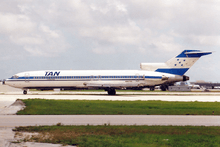Tan-Sahsa Flight 414
 N88705, the aircraft involved in the accident, at Miami International Airport in 1989. | |
| Accident | |
|---|---|
| Date | 21 October 1989 |
| Summary | Pilot error and possible criminal negligence |
| Site |
9 km south of Cerro de Hula, Tegucigalpa, Honduras 13°56′43″N 87°14′27″W / 13.94521°N 87.24084°WCoordinates: 13°56′43″N 87°14′27″W / 13.94521°N 87.24084°W |
| Aircraft | |
| Aircraft type | Boeing 727-224 |
| Operator | Tan-Sahsa |
| Registration | N88705 |
| Flight origin | Juan Santamaría International Airport, San José, Costa Rica |
| Stopover | Augusto C. Sandino International Airport, Managua, Nicargua |
| Destination | Toncontin International Airport, Tegucigalpa, Honduras |
| Passengers | 138 |
| Crew | 8 |
| Fatalities | 131 |
| Injuries | 15 (20 initially) |
| Survivors | 15 |
Tan-Sahsa Flight 414 was a scheduled flight from Juan Santamaría International Airport, San José, Costa Rica to Toncontin Airport in Tegucigalpa, Honduras, with a stopover at Augusto C. Sandino Airport in Managua, Nicaragua on 21 October 1989.[1] Flown with a Boeing 727-200, the flight crashed into a hill of the mountain range after the pilots failed to follow a special landing procedure required for the arrival to the airport, killing 131 passengers, leaving 15 survivors. 20 initially survived, but five died before treatment, due to a delay in rescue personnel from the bad weather.[2] This accident is the deadliest accident in Central American history.[3]
Aircraft History
The aircraft was a Boeing 727-224, registered as N88705, leased from Continental Airlines, and first flown in 1968. It was delivered to Tan-Sahsa in 1981.[4]
Flight and Accident

The flight crew of 414 consisted of 34-year-old Captain Raúl Argueta, 26-year-old First Officer Reiniero Canales, both employed at Tan-Sahsa.
Tegucigalpa ATC cleared the flight for the VOR/DME approach to runway 01. Because of high terrain in the area, the approach uses a series of three step-downs from the initial approach fix of 7500 feet MSL.[4] The crew began a continuous descent from about 7600 ft MSL at about 11 NM from the airport, rather than following the prescribed step-down procedure, which led to the accident site.[4] The aircraft's descent profile was well below the published step-down course for the entire approach. The aircraft impacted a mountain known as Cerro de Hula at the 4800 ft MSL elevation, approximately 800 ft below the summit, 4.8 NM from the Tegucigalpa runway 01 threshold.[5] At impact, the aircraft was in approach configuration.[4]
The plane broke into three sections. The first part (Cockpit, First Class), contained almost all of the survivors of the accident,[6] due to the close-to-stall, nose high configuration at impact.
Aftermath
While the National Transportation Safety Board and the Civil Aviation Authority of Honduras were investigating the crash, Raúl and Canales were charged with manslaughter and negligence and went to trial. However, the case was never resolved.[7] Five months later another aircraft, an L-188 Electra operated by Sahsa Carga registered as HR-TNL, crashed in the close the Flight 414's site, with a similar cause, making it the third accident by Sahsa in six months.[8] Due to its bad safety history and corruption, Tan-sahsa went into bankruptcy in the 1990s, and ceased operations in 1994
References
- ↑ Ring, Wilson (1989-10-22). "HONDURAN JET CRASH KILLS AT LEAST 100". Washington Post. ISSN 0190-8286. Retrieved 2018-01-01.
- ↑ Services, From Times Wire (1989-10-22). "Honduran 727 Hits Mountain; at Least 131 Die". Los Angeles Times. ISSN 0458-3035. Retrieved 2017-12-31.
- ↑ Herzfelder, Richard (22 October 1989) Honduran Air Crash Survivors Describe Scenes of Horror. Associated Press.
- 1 2 3 4 "21-OCT-1989 TAN-SAHSA flight 414". Aviation Safety Network. Retrieved 23 September 2013.
- ↑ AP (1989-10-22). "Plane Crashes in Honduras, Killing at Least 131". The New York Times. ISSN 0362-4331. Retrieved 2018-01-01.
- ↑ "Google Drive Viewer". Docs.google.com. Retrieved 7 September 2013.
- ↑ "LOS GRANDES ACCIDENTES AEREOS EN EL MUNDO". grandesaccidentesaereos.blogspot.com. Retrieved 2017-12-30.
- ↑ "Foro CatrachoWings :: View topic – Accidentes/Incidentes". Catrachowings.com. Retrieved 7 September 2013.